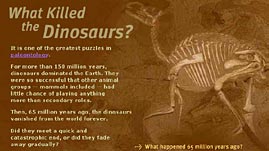Teachers' Domain - Digital Media for the Classroom and Professional Development
User: Preview


Source: Evolution Web Site
Definitive answers to some of life's most enduring questions are often difficult or impossible to come by. However, scientific processes piece together the information that is available as a way of providing alternative explanations for a wide variety of phenomena. This interactive activity from the Evolution Web site outlines the evidence gathered to explain what caused the extinction of the dinosaurs 65 million years ago. It proposes four possible hypotheses and invites you to consider the evidence and come to your own conclusion.
Can we ever know for certain what caused the dinosaurs to go extinct 65 million years ago? The answer is no. Without going back in time, we can't know for certain what sealed the fate of this once-dominant group of animals. But that doesn't mean we shouldn't ask the question. It also doesn't mean that we can't vastly improve our understanding of how various events might have affected dinosaurs. With enough evidence, this understanding could lead to the acceptance of one particular explanation as more likely than all others. This, after all, is the objective of scientific inquiry.
Science attempts to answer questions and solve problems. Some deal with current phenomena, while others look at happenings in the distant past. Some are engineering problems, while others involve questions about ecology or neurology. Despite this wide variety of challenges, scientists of all disciplines follow common systematic steps or processes in pursuit of explanations and solutions.
Like most scientific investigations, the pursuit of an explanation for the extinction of the dinosaurs began with observations. Paleontologists found evidence in the fossil record that dinosaurs once roamed the Earth. They also observed that from 65 million years ago to the present there is no evidence of this diverse group. This raised the question: What caused their extinction? This question in turn inspired follow-up questions, such as: What was happening ecologically and geologically 65 million years ago that might relate to the extinction? Did organisms other than dinosaurs go extinct at the same time? What happened to other groups of organisms after the dinosaurs went extinct? and What evidence might help to answer these questions?
Such follow-up questions are instrumental in helping scientists focus their search for answers to larger questions. For example, to better understand what was happening geologically and ecologically before dinosaurs became extinct, scientists went back to the fossil record. They searched the sedimentary layers laid down near the time of the extinction for more evidence. In this layer, known among paleontologists as the K/T boundary, they found signs of high levels of volcanic activity. They also found evidence of climate change, high concentrations of a rare metal most often found in asteroids, and fossils of mammals coexisting with dinosaurs prior to the extinction.
These pieces of evidence, along with many other clues, suggest that it may be too early to discard any of the four prominent hypotheses. However, most scientists agree that the asteroid-impact hypothesis is supported by the most convincing collection of evidence.
To learn more about other events recorded in Earth's geologic record, check out Deep Time.
 Loading Standards
Loading Standards Teachers' Domain is proud to be a Pathways portal to the National Science Digital Library.
Teachers' Domain is proud to be a Pathways portal to the National Science Digital Library.
